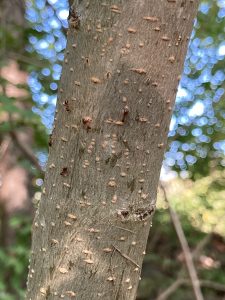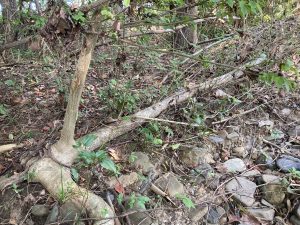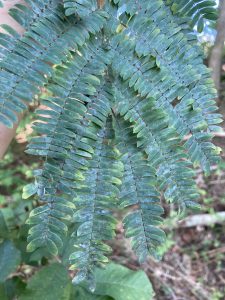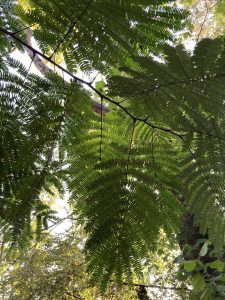I arrived at my sit spot at 6:24 PM, October 7th, 2020. I immediately knew which organism I wanted to observe. I picked an interesting looking tree that is located directly behind my sit spot. Every time I visit, I am always curious as to what kind of tree it is, so this blog post should help satisfy my curiosity. After consulting multiple plant identification apps and google, I have determined my organism to be a Persian silk tree. I could not believe this at first. Why would there be a silk tree from Persia in southern Virginia? But after doing a bit more research, it was the tree that most resembled my organism. I chose this tree because of how unique it is. Because I have lived in Virginia for my entire life and love to explore, I generally know or have seen many plants from around here, but I was very confused by my organism.
 The tree itself is not very tall, maybe only 8 feet, but it appears to be growing from a fallen trunk. I find this to be very interesting because it shows how the tree adapted to survive despite getting knocked over. Close to the top, many spindly branches veered out, creating a sort of umbrella shape. From the main branches, smaller twigs with waxy, opposite sets of leaves hung down. Originally, I thought this tree was a kind of pine, but after taking a closer look, I realized how much different it was compared to any other forest tree I have seen. The bark is quite smooth, but it has small bumps scattered across the surface. Ants really seemed to enjoy this tree, climbing up and down the trunk. From the pictures I could find of Persian silk trees, they seemed to have fluffy, spindly pink flowers, but there were none on my specimen. I assume they blossom in early summer or late spring. I will have to watch closely as the school year progresses.
The tree itself is not very tall, maybe only 8 feet, but it appears to be growing from a fallen trunk. I find this to be very interesting because it shows how the tree adapted to survive despite getting knocked over. Close to the top, many spindly branches veered out, creating a sort of umbrella shape. From the main branches, smaller twigs with waxy, opposite sets of leaves hung down. Originally, I thought this tree was a kind of pine, but after taking a closer look, I realized how much different it was compared to any other forest tree I have seen. The bark is quite smooth, but it has small bumps scattered across the surface. Ants really seemed to enjoy this tree, climbing up and down the trunk. From the pictures I could find of Persian silk trees, they seemed to have fluffy, spindly pink flowers, but there were none on my specimen. I assume they blossom in early summer or late spring. I will have to watch closely as the school year progresses.

After doing some research, I discovered Persian silk trees are commonly planted in parks and gardens as ornamental plants. They have a very fast growth rate and low water requirements. They thrive in hot, full sun environments. They have a thick, leafy canopy that provides good shade. There are two main variants, one of which does better in cooler environments. I am not too sure which variant my organism is, but I should be able to tell once it flowers. The flowers provide sweet nectar that butterflies and honeybees enjoy. Persian silk trees are an invasive species in the US, stretching from the west coast and the southern US all the way up to Connecticut and southern New York. It was first cultivated in Oregon and California. Its seeds are held in pods, each containing about 8, and are fertile over long periods of drought. The pods burst in strong winds, and the seeds carry over surprisingly long distances. The tree is generally short-lived and very susceptible to a fungal disease called mimosa vascular wilt.

It was a bit frustrating trying to identify my organism, mainly because I was certain my identification app was wrong. I took multiple images of the tree, trying to get different angles and parts of the tree in the photo. Every time it kept coming up as a Persian silk tree. I googled images and, sure enough, my app seemed to be correct. Just to be sure that was correct, I downloaded another identification app and it came up as a Persian silk tree. By that point, I had accepted the identity of the tree.
Overall, the experience was a bit uneventful. It was strange to visit my sit spot for such a short amount of time, but I did not dislike it. I feel it would have been more engaging if I studied an animal rather than a plant, but I had a general idea of most of the common organisms found at my sit spot. Besides, plants are a lot easier to study than an animal that would simply run away before 30 minutes was up. I would not be opposed to doing something like this again, but I feel I enjoy focusing on my general surroundings rather than a single organism.

I have always seen these trees and wondered what they were. I’m really glad you wanted to know as well haha I really enjoyed this article! It was really interesting especially since I have always wondered what they were. Good job!!